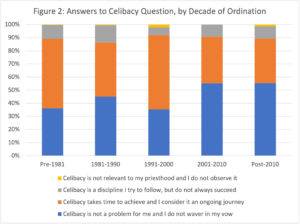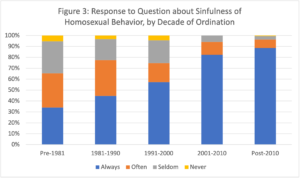It has been nearly 20 years since the Los Angeles Times conducted a survey of Catholic priests, a venture that yielded much study and commentary about the state of the priesthood in the United States. The results suggested priests believed they were facing the biggest crisis in a century—the abuse scandal—but nevertheless were generally upbeat about their lives as priests.
In late 2020 and early 2021, the Austin Institute fielded a survey replicating a variety of those same questions posed in 2002, aiming to create a dataset that might help analysts understand what has and has not changed over two decades. Here I discuss a portion of what a first round of analyses reveals about answers to questions on priestly sexual identity, behavior, and attitudes—from a co-authored study now accessible at the Social Science Research Network. Tomorrow in Public Discourse, sociologist Brad Vermurlen will discuss a broader series of questions about the state of the American priesthood, the topic of the second of a pair of studies.
It is well documented that the prevalence of homosexuality among Catholic priests is higher than the same within the general population. (I use the term “homosexuality” here in part because Church documents tend to privilege the word, but mostly because comparatively few clergy would use terms like “gay” to describe themselves or their fellows who experience consistent same-sex attractions.) Figures, however, have varied widely. Most recently, sociologist Paul Sullins estimated that about 17 percent of Catholic priests in the United States are homosexual in orientation, a rate around 4 to 5 times that discernible in the wider population. The share of homosexual priests rose during the 1980s, he maintains, but has diminished since the 1990s, and considerably so after 2000.
The dip—or plunge, if older, higher estimates were accurate—seems in step with new scrutiny placed on sexual orientation during the “vocational discernment” process, shorthand for the process in which Catholic men commence their seminary education, continue their studies, or leave the seminary altogether. (Of course, many leave the seminary for other reasons.) Sexual orientation is not, however, understood in a rigid or binary fashion, and distinctions are important. The guidance regarding seminarians recognizes this: previous experience with “homosexual tendencies” is permissible, so long as they were “only the expression of a transitory problem” and have been “clearly overcome at least three years before ordination to the diaconate.” And regardless, all priests are—according to canon law—expected to “observe perfect and perpetual continence for the sake of the kingdom of heaven and therefore are bound to celibacy.” Priestly celibacy is nevertheless regularly criticized as exceptional or unnatural, and remains a popular (but unfair, in my opinion) source of blame for the abuse scandal.
The seminary environment has long been understood as having the capacity to shape, constrain, and direct trajectories in terms of the sexual habits and attitudes of seminarians. Pope Emeritus Benedict XVI offered rare post-retirement remarks in 2019 on the subject of seminary culture in the 1960s and ’70s, observing that in “various seminaries homosexual cliques were established, which acted more or less openly and significantly changed the climate in the seminaries.” The result, he believed, was a “far reaching breakdown” in standard methods of priestly formation—one that dovetailed with increasingly permissive sexual norms in the wider culture. Was he prescient?
Trends in Priests’ Sexual Orientation
The 2021 Survey of American Catholic Priests, which I did not conduct myself but on whose design I did consult, drew on two different sampling frames in its survey, which was completed by just over 1,000 priests. This should not, however, be considered a random sample of priests. It is, instead, the product of surveying priests from a pair of extensive lists: (1) the Official Catholic Directory, which served as the source of the 2002 LA Times sampling frame, and (2) the mailing list of a large Catholic nonprofit organization.
It is reasonable to wonder whether priests would be honest on a survey that queried them about sexual matters. The late sociologist and priest Andrew Greeley wondered the same, but held that—so long as they are guaranteed confidentiality—people tend to be frank about their activities. (I concur.) There are seven figures and nine tables in the study. I only display three figures here—all from the 2021 data collection effort. Figure 1 graphs the self-identified sexual orientation of priest respondents by years since their ordination. Figure 1 indicates that a self-identified homosexual orientation is notably more common among ordinations that occurred before the year 2000—between 11 and 15 percent—than it is after 2000 (2–3 percent). The same is true of respondents’ selection of the category “somewhere in between, but more on the homosexual side,” the response given by 7–9 percent of respondents with pre-2000 ordinations but only 3.2–3.5 percent of those more recently ordained.
On the other end, a heterosexual orientation appears to be a linear function of the date of ordination. It ranges from 59 percent of pre-1980 ordinations to 89 percent of those priests ordained after 2010. When we make projections of this question out 20 years from now (not shown here), we estimate that by 2041 the share of Catholic priests who would self-identify as either entirely or mostly heterosexual should amount to over 92 percent, while those who would self-identify as either entirely or mostly homosexual would amount to 7 percent.
Priests and Celibacy
Figure 2 depicts the respondents’ answers to the survey’s question about celibacy, again sorted by decade of ordination for the 2021 samples. Unlike the sexual orientation measure in Figure 1—which offers a spectrum of responses that has a measurement history to it—the question about celibacy posed in the 2002 LA Times survey (and replicated verbatim in 2021 for comparability) is a bit clunkier. Its answers feature more nuance than a scale of sorts. A trendline among ordination cohorts here is less prominent. And yet the bottom category—“Celibacy is not a problem for me and I do not waver in my vow”—was chosen by fewer respondents before 2001 than it was after. Fifty-five percent of priests ordained on or after 2001, up to the present, selected this response.
At the other extreme, very few priests—never more than two percent and typically less—report that “celibacy is not relevant to my priesthood and I do not observe it.” Among priests ordained before 2000, the modal response to the question about celibacy is that it “takes time to achieve” and that “it is a journey.” After 2000—hence among younger priests—the modal answer shifts to that of greater confidence and commitment. Post-2010 ordinations appear even more so. Neither the 2002 nor the 2021 survey probes further here, querying on the nature or frequency of non-celibate behavior.
While one may surmise that perhaps time reveals the challenges of celibacy, implying younger priests might change how they answer the question over time, the larger study also reveals a role for sexual self-identity. Simply put, self-identified homosexual priests—together with those who identify with gradations close to homosexuality (or bisexuality)—are notably less apt to report that celibacy is not a problem and that they do not waver in the vow, regardless of when they were ordained. This is evident in the regression tables in the study (not displayed here).
Priests’ Attitudes on Homosexuality
Figure 3 is about an attitude rather than an identity or behavior pattern. It displays the respondent’s opinion about a question on the sinfulness of particular practices, in this case homosexual behavior. Priest respondents were asked whether the behavior was “always, often, seldom, or never” a sin.
The response patterns are striking. Among priests ordained before 1981, 34 percent responded “always” to the question about homosexual behavior as sinful, and an additional 33 percent said “often.” The “always” response grows in a linear fashion up through the most recent cohort: 45 percent (1981–1990), 57 percent (1991–2000), 82 percent (2001–2010), and 89 percent among those ordained after 2010. The Catholic priesthood in the United States is becoming demonstrably more conservative on homosexual behavior over time.
A look at other answer options to this question reveals that it is not simply that the “middle” answers are hollowing out; rather, post-2000 ordinands are also notably less likely to select “often” and “seldom” as answers. Just under 35 percent of pre-1981 ordinands asserted that homosexual behavior is “seldom” or “never” a sin, whereas only 6 percent of 2001–2010 ordinands and 4 percent of post-2010 ordinands chose these answers.
Younger Priests’ Views on Sex Are More Conservative
The full working paper offers an overview of an additional trio of priestly attitudes about the Church’s teaching on premarital sex, masturbation, and contraception among married couples. In regression models (not shown here), priests—regardless of age—who are either homosexual and/or not committed to celibacy are predictably much less likely to identify all four sexual behaviors as sinful. That is, those who dissent in one domain are far more apt to dissent in others. Or to quote George Weigel’s expression from his recent book Lessons in Hope, “men who lived lives of intellectual deception, pretending they accepted Church teachings with which they disagreed, and that they had no intention of promoting, learned to live lives of deception in their sexual conduct as well.”
Meanwhile, the number of ex-Catholics is surging. While even the average engaged Catholic continues to show signs of making peace with progressive trends in sexuality and relationship behavior, the same is not true among the clergy. Nationally, vocations to the priesthood—at least as measurable in seminary enrollments—are neither increasing nor decreasing notably. But if one understands the celibate life as “costly” in particular ways, then conservative or traditional Catholic men appear more willing to pay that cost. The type of man who completes seminary intending ordination is more conservative about matters of sexuality—as well as other markers—than those who enrolled 20, 30, or 40+ years ago.
Whether this is a function of self-selectivity at the start or of heightened scrutiny of vocations along the way (by seminary rectors, vocations directors, etc.) is beyond the reach of our study to assert. I nevertheless suspect both of these are operative. Greeley, as well as others, saw this development coming decades ago, writing about it in an Atlantic Monthly article humorously entitled “Young Fogeys.” (He was not, in general, enthused.) But what kind of young Catholic man is formed well enough to pursue the priesthood amid all the noise today? It is not the progressive. My best guess—and it is only that—is that they were formed first, and well, in a thriving domestic church.
There is a lot more to say about this study and its companion piece about wider aspects of the priestly life, highlights from which will be published tomorrow here in Public Discourse. More details—including weighting procedures as well as some reasonable concerns about the data, sample size, and potential biases therein—are available in the study itself, downloadable from the Social Science Research Network, an online depository that is becoming an increasingly common resource for vetting new research. The 2021 survey data themselves have already been deposited at the Association of Religious Data Archives, where they should be publicly accessible by late November.









